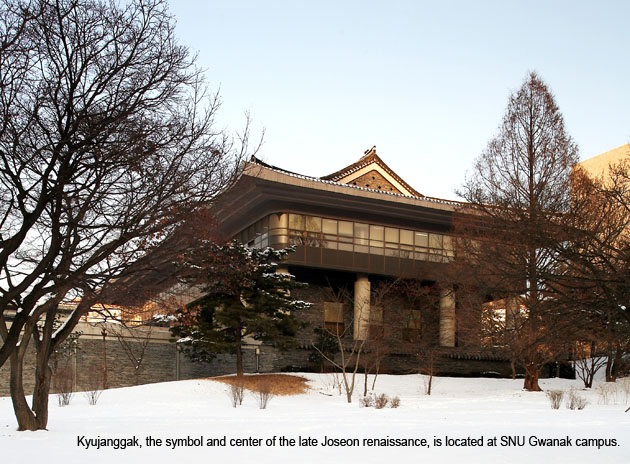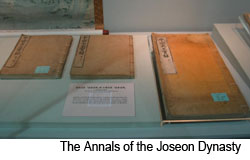
"This is where my dream will come true."
This is what King Jeongjo of the Joseon dynasty (1392-1910) exclaimed as he looked upon Kyujanggak, which had just been constructed in 1776. One cannot talk about the Jeongjo era without mentioning Kyujanggak, the symbol and center of the late Joseon renaissance. Kyujanggak was originally a royal archive that stored and managed documents such as the writings of the former kings, seals, portraits, and genealogical records. However, with Jeongjo's accession to the throne in 1776, it expanded into an academic center where royal scholars carried out research, collected and published reference material for state affairs, and even provided counsel for the king.
Kyujanggak’s archives were taken over by Japan after the Joseon dynasty fell and Korea was annexed by Japan in 1910. After Korea gained independence from Japan in 1945, SNU became responsible for managing the archives. In 1992, Kyujanggak was separated from the SNU central library and became an independent organization. In 2006, it was combined with the Institute of Korean Studies, and took the current form becoming the Kyujanggak Institute for Korean Studies.
Currently, Kyujanggak's archives consist of 260,000 volumes of ancient maps, paintings and calligraphic works, as well as books -- of which 7078 volumes, including the Annals of the Joseon Dynasty and Seungjeongwon Ilgi: The Diaries of the Royal Secretariats, are designated as national treasures. Moreover, the Annals of the Joseon Dynasty and the Uigwe have been inscribed in the UNESCO Memory of the World Register, designating them as unique world documentary heritage.
As the largest and most accurate collection of historical records of the Joseon era (1392-1910), the Kyujanggak possesses archives whose value is unmatchable by others. Kyujanggak has many relics that are so famous for their historic value that, other items, even with considerable academic value, often do not get the attention they would receive if they were stored elsewhere. According to common opinion, here are the most precious relics in the Kyujanggak collection.
The Annals of the Joseon Dynasty (Joseon wangjo sillok, 1,229 volumes)
 The Annals of the Joseon Dynasty are a series which documented the history of the dynasty chronologically, focusing mainly on the actions of the kings. Because they were written by the royal historians, what was written in the annals could be considered the dynasty’s official history. The Joseon dynasty took documentation very seriously. Because it considered history a source of wisdom for future kings, even the king could not tamper with the historical records kept by the royal historians. The history of a certain king’s reign would only be written after his death, so that the records would not be biased in favor of him. This collection covers 472 years of the history of the dynasty, from the reign of its founder, King Taejo (r. 1392 - 1398), to the rule of King Cheoljong (r. 1849 - 1863), the 25th king. Because this collection is so vast and detailed in historical data, it is a priceless document for historians, especially for those who study the history of the early period of the Joseon dynasty, as other records are comparatively scarce from that period. The Annals were designated as national treasure no. 151 in 1973.
The Annals of the Joseon Dynasty are a series which documented the history of the dynasty chronologically, focusing mainly on the actions of the kings. Because they were written by the royal historians, what was written in the annals could be considered the dynasty’s official history. The Joseon dynasty took documentation very seriously. Because it considered history a source of wisdom for future kings, even the king could not tamper with the historical records kept by the royal historians. The history of a certain king’s reign would only be written after his death, so that the records would not be biased in favor of him. This collection covers 472 years of the history of the dynasty, from the reign of its founder, King Taejo (r. 1392 - 1398), to the rule of King Cheoljong (r. 1849 - 1863), the 25th king. Because this collection is so vast and detailed in historical data, it is a priceless document for historians, especially for those who study the history of the early period of the Joseon dynasty, as other records are comparatively scarce from that period. The Annals were designated as national treasure no. 151 in 1973.
The Essence of the Old and New in the History of the Seventeen Countries (Shipchilsa chan gogeum tongyo, 1 volume)
This is a history book originally written by a scholar of the Yuan dynasty of China, Hu Tingfang, who summarized the history of 17 countries by selecting the essence of preexisting historical records. What makes the copy stored in Kyujanggak special is the way it was printed. It was printed with the Gyemija, which is the first copper printing press of the era, made in 1403 (the third year of the reign of King Taejong). This predates Gutenberg’s metal printing press (invented in 1453) by half a century. It was designated as national treasure no. 148 in 1973.
Seungjeongwon Ilgi: The Diaries of the Royal Secretariat (3,243 volumes)
Seungjeongwon Ilgi (ilgi means ‘diary’ in Korean) has the largest amount of authentic historic recordings and state secrets of the Joseon Dynasty from the 17th century to the early 20th century, which makes it a crucial record for studying the history of the latter half of the Joseon period. Seungjeongwon was the royal secretary department. This diary held a vast record of royal orders, administrative affairs, and various ceremonies from the early era of Joseon, but was destroyed in the Japanese invasion in 1592. Now only records from 1623 (King Injo, the 16th king) to 1894 (the 31st year of the reign of Gojong, the 26th king) remain. The diary is astonishingly detailed, containing minute observation by the secretaries about nearly everything that happened in the palace, official and private. The diary contains monthly records of government meetings, the status of the royal family, and even the most seemingly insignificant details such as the attendance of Seungjeongwon officers and night duty workers.
Woodblocks of the Gonyeojeondo (Map of the World)
This is a woodblock made in 1860 to print and reproduce the Gonyeojeondo, a map of the world originally made in Beijing in 1674 by Ferdinand Verviest, and then imported to Joseon in 1721. Verviest was a Belgian missionary who introduced Western astronomy and science to China, influencing the Asian intellectuals. The reason the map was carved into woodblocks for mass production a century after its importation was to raise awareness of the Western powers, which had already extended their influence to China by that time (the Opium War was in 1840). Out of the 4 woodblocks, only 3 remain. They were designated as treasure no. 882 in 1986.
Daedongyeojido (“Territorial Map of the Great East”)
 This giant map, 660cm long and 410cm wide, is displayed at the entrance of Kyujanggak’s exhibition room. The map was made in 1861 by Kim Jeongho, a cartographer of the Joseon era. A masterpiece of Joseon cartography, the Daedongyeojido is detailed and accurate enough to match even modern day maps. The approximate scale is 1:160,000. The map, while maintaining the traditional method of describing the boundaries of mountains and rivers, is equipped with various legends and signs on roads that mark every 10 lis (a ‘li’ is a traditional measure of length: about 400 meters). Above all, it is an aesthetic masterpiece of craftsmanship, which makes it even more valuable.
This giant map, 660cm long and 410cm wide, is displayed at the entrance of Kyujanggak’s exhibition room. The map was made in 1861 by Kim Jeongho, a cartographer of the Joseon era. A masterpiece of Joseon cartography, the Daedongyeojido is detailed and accurate enough to match even modern day maps. The approximate scale is 1:160,000. The map, while maintaining the traditional method of describing the boundaries of mountains and rivers, is equipped with various legends and signs on roads that mark every 10 lis (a ‘li’ is a traditional measure of length: about 400 meters). Above all, it is an aesthetic masterpiece of craftsmanship, which makes it even more valuable.
Han Seok-bong’s Calligraphy Scrapbook
Han Seok-bong was the most famous calligrapher in the mid-Joseon era. Calligraphy was one of the most popular forms of art at that time. Because his style was so beautiful, people made engravings to duplicate and preserve it on solid material instead of paper. While many of these engravings were not elaborate enough to fully duplicate the beauty of the original calligraphy, the one housed in Kyujanggak was carved with exquisite craftmanship. The scrapbook is the most successful reproduction of this engraving, with Chinese poetry and prose written in kai-shu style calligraphy. The scrapbook contains about 10 prose texts about Wang Xi-zhi (a famous Chinese calligraphist) and Li Bai (a famous Chinese poet), and two poems written by Li Bai.
Kyujanggak, Meeting the Public
Kyujanggak is setting up a number of programs for the public to promote the importance of history and tradition.
The items displayed in the exhibition hall are changed every six months, and a special exhibition is held every year to catch the attention of the public. Since 2008, Kyujanggak has recruited student volunteers to guide foreign visitors through the collections, just in case they have questions beyond the English explanations that are already provided beneath each item. Lastly, the institute has organized a series of lectures on research methodology and the recorded heritage of Korea.
Written by KIM Jaeseung, SNU English Editor, brainophone@naver.com ?
Reviewed by Eli Park Sorensen, SNU Professor of Liberal Studies, eps7257@snu.ac.kr
Proofread by Brett Johnson, SNU English Editor, morningcalm2@gmail.com

